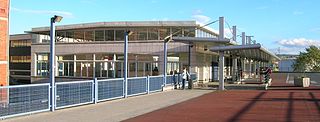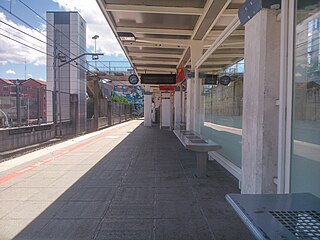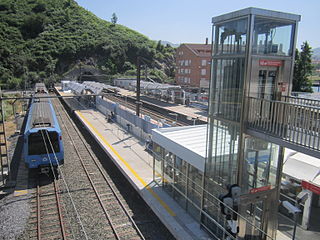
Euskotren Trena, formerly known just as Euskotren is a commuter, inter-city and urban transit train-operating company that operates local and inter-city passenger services in the provinces of Biscay and Gipuzkoa, in the Basque Country, Spain. It is one of the four commercial brands under which Euskotren operates, as a public company managed by the Basque government. The entire 181.1-kilometre (112.5 mi) network uses 1,000 mm narrow gauge rail tracks which have been owned by the Basque Government since their transferral from the Spanish government; the rail tracks and stations were part of the FEVE network until its transferral. Euskotren Trena also operates the Donostia/San Sebastián metro under the brand Metro Donostialdea.

Zazpikaleak/Casco Viejo is a railway station in Bilbao, Basque Country, Spain. It is located in the historical neighborhood of Casco Viejo, in the district of Ibaiondo. It links the Bilbao metro rapid transit services with the Euskotren Trena commuter rail network. It is the main railway hub for trips between the metropolitan underground network and the railway services to Eibar, Gernika, Bermeo and San Sebastián as well as the Txorierri valley. The original metro station opened on 11 November 1995, and on 8 April 2017 in its current form.

Lutxana is a station of line 1 of Metro Bilbao, also served by the Lutxana-Sondika shuttle operated by Euskotren Trena. It is located in the neighbourhood of Lutxana-Enekuri, in the municipality of Erandio. In its current inception, the station was opened on 11 November 1995. Since 2015, the station has also been served by Euskotren Trena suburban trains.

Erandio is a station on line 1 of the Bilbao metro. It is located in the neighborhood of Altzaga, in the municipality of Erandio. The station opened as part of the metro on 11 November 1995.

Astrabudua is a station on line 1 of the Bilbao metro. It is located in the neighborhood of the same name, in the municipality of Erandio. The station opened as part of the metro on 11 November 1995, replacing an older station. It is located next to a fare-free parking.

Leioa is a station on line 1 of the Bilbao metro. It is located in the neighborhood of Udondo, in the municipality of Leioa. The station opened as part of the metro on 11 November 1995, replacing an older station. It is located next to a park and ride facility.

Lamiako is a station on line 1 of the Bilbao metro. It is located in the neighborhood of Lamiako, in the municipality of Leioa. The station opened as part of the metro on 11 November 1995, replacing an older station.

Areeta is an underground station on line 1 of the Bilbao metro. It is located in the neighborhood of Areeta, in the municipality of Getxo. The station opened as part of the metro on 11 November 1995, replacing an older overground station.

Gobela is a station on line 1 of the Bilbao metro. It is located in the neighborhood of Itzubaltzeta-Romo, in the municipality of Getxo. The station opened as part of the metro on 24 June 1996, replacing an older station. It is located immediately to the west of Campo Municipal de Gobela, home of the football team Arenas Club de Getxo.

Neguri is a station on line 1 of the Bilbao metro. It is located in the neighborhood of Neguri, in the municipality of Getxo. The station opened as part of the metro on 11 November 1995, replacing an older station.

Algorta is a station on line 1 of the Bilbao metro. It is located in the neighborhood of Algorta, in the municipality of Getxo. The station opened as part of the metro on 11 November 1995, replacing an older station.

Bidezabal is a station on line 1 of the Bilbao metro. It is located in the neighborhood of Algorta, in the municipality of Getxo. The station opened as part of the metro on 11 November 1995.

Berango is a station on line 1 of the Bilbao metro. It is located in the municipality of Berango. The station opened as part of the metro on 11 November 1995.

Larrabasterra is a station on line 1 of the Bilbao metro. It is located in the neighborhood of Larrabasterra, in the municipality of Sopela. The station opened as part of the metro on 11 November 1995.

Sopela is a station on line 1 of the Bilbao metro. It is located in the municipality of Sopela. The station opened as part of the metro on 11 November 1995. The station was originally named Sopelana after the municipality, which changed its name to Sopela in 2014, the station's name also being changed shortly thereafter.

Urduliz is a station on line 1 of the Bilbao metro. It is located in the municipality of Urduliz. Originally an overground station belonging to the Bilbao-Plentzia railway, the station was rebuilt and put underground in 2017.

Matiko is the northern terminus of line 3 of the Bilbao metro. The station is also served by Euskotren Trena commuter and regional rail services. The station is located in the neighborhood of Matiko-Ciudad Jardín, part of the Uribarri district of Bilbao. In its current form, the station opened on 8 April 2017.

Sondika is a railway station in Sondika, Basque Country, Spain. It is owned by Euskal Trenbide Sarea and operated by Euskotren. It lies on the Txorierri line.

The Lutxana-Sondika line is a single-track branchline in Biscay, Basque Country, Spain. Owned by Euskal Trenbide Sarea, it runs from Lutxana to Sondika, connecting line 1 of the Bilbao metro with the Txorierri line. It is a remnant of the former Lutxana-Mungia line, which was partially closed in May 1975.
Ferrocarriles y Transportes Suburbanos, commonly known by its acronym FTS, was a railway company in the Basque Country, Spain. Founded in 1947 as the merger of various railway companies, it operated several suburban rail lines in the Greater Bilbao area. FEVE took over its operations in 1972, which in 1982 were transferred to the new company Basque Railways.



















